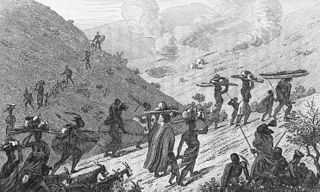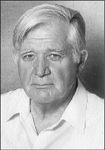Related Research Articles

Shaka kaSenzangakhona, also known as Shaka Zulu and Sigidi kaSenzangakhona, was the king of the Zulu Kingdom from 1816 to 1828. One of the most influential monarchs of the Zulu, he ordered wide-reaching reforms that reorganized the military into a formidable force.
Nandi KaBhebhe was a daughter of Bhebhe, a past Elangeni chief and the mother of Shaka kaSenzangakhona, King of the Zulus.

Durban is the third-most populous city in South Africa, after Johannesburg and Cape Town, and the largest city in the province of KwaZulu-Natal. Situated on the east coast of South Africa, on the Natal Bay of the Indian Ocean, Durban is South Africa's busiest port and was formerly named Port Natal. North of the harbour and city centre lies the mouth of the Umgeni River; the flat city centre rises to the hills of the Berea on the west; and to the south, running along the coast, is the Bluff. Durban is the seat of the larger eThekwini Metropolitan Municipality, which spans an area of 2,556 km2 (987 sq mi) and had a population of 4.2 million in 2022, making the metropolitan population one of Africa's largest on the Indian Ocean. Within the city limits, Durban's population was 595,061 in 2011. The city has a humid subtropical climate, with hot, wet summers and mild, dry winters.

The Mfecane, also known by the Sesotho names Difaqane or Lifaqane, was a historical period of heightened military conflict and migration associated with state formation and expansion in Southern Africa. The exact range of dates that comprise the Mfecane varies between sources. At its broadest, the period lasted from the late eighteenth century to the mid-nineteenth century, but scholars often focus on an intensive period from the 1810s to the 1840s. The concept first emerged in the 1830s and blamed the disruption on the actions of King Shaka, who was alleged to have waged near-genocidal wars that depopulated the land and sparked a chain reaction of violence as fleeing groups sought to conquer new lands. Since the latter half of the 20th century, this interpretation has fallen out of favor among scholars due to a lack of historical evidence.
Dingiswayo was a Mthethwa King, well known for his mentorship over a young Zulu general, Shaka kaSenzangakhona, who rose to become the greatest of the Zulu Kings. His father was the Mthethwa King, Jobe kaKayi. It was under King Dingiswayo that the Mthethwa rose to prominence, mostly employing diplomacy and assimilation of nearby chiefdoms to strengthen his power base. According to Mthethwa (1995), the Mthethwas are descended from the Nguni peoples of northern Natal and the Lubombo Mountains, whose modern identity dates back some 700 years.
The following lists events that happened during 1823 in South Africa.
Francis George Farewell (1784–1829) was the founder of the Port Natal Colony in South Africa.
Nathaniel Isaacs (1808–1872) was an English adventurer who played a part in the history of Natal, South Africa. He wrote a memoir spread over two volumes called Travels and Adventures in Eastern Africa (1836). This book subsequently became one of the principal sources quoted by writers of the history of Natal, including Morris , Ritter and Bulpin.

The 1820 Settlers were several groups of British colonists from England, Ireland, Scotland, and Wales, settled by the government of the United Kingdom and the Cape Colony authorities in the Eastern Cape of South Africa in 1820.

Pieter Mauritz Retief was a Voortrekker leader. Settling in 1814 in the frontier region of the Cape Colony, he later assumed command of punitive expeditions during the sixth Xhosa War. He became a spokesperson for the frontier farmers who voiced their discontent, and wrote the Voortrekkers' declaration at their departure from the colony.
Henry Melville Taberer was a South African cricketer who played in one Test match in 1902. He was the son of the Revd C. Taberer and was born at a mission station in Keiskammahoek, Cape Province.

The Colony of Natal was a British colony in south-eastern Africa. It was proclaimed a British colony on 4 May 1843 after the British government had annexed the Boer Republic of Natalia, and on 31 May 1910 combined with three other colonies to form the Union of South Africa, as one of its provinces. It is now the KwaZulu-Natal province of South Africa.

Frederick Guy Butler was a South African poet, academic and writer.

Leonard Noel Fisher was an Anglican bishop in the second quarter of the twentieth century. After parish work in England and military service in the First World War, he served as bishop in two African dioceses, Lebomo and Natal, before retiring in 1951.

Charles Rawden Maclean, also known as "John Ross", was born on 17 August 1815 in Fraserburgh and died 13 August 1880 at sea on the RMS Larne while en route to Southampton. In a tribute to him during the re-dedication of his grave in Southampton in 2009, the Zulu War author and broadcaster Ian Knight said:
Maclean was a champion of liberty and his stone will be one of the few inscriptions in a British cemetery which commemorates a positive interaction between the British and Zulu people; most existing memorials commemorate individuals who were involved in Anglo-Zulu conflict.

Ebenezer St Mark Ntlali is a South African Anglican retired bishop. He was the fourteenth Bishop of Grahamstown.

Sir George Edward Cory, was an English-born South African chemist and historian, best known for his six-volume publication "The Rise of South Africa".
Christopher Michael "Zithulele" Mann was a South African poet.
Peter Bingham Hinchliff was a South African Anglican priest and academic. He was the Regius Professor of Ecclesiastical History at the University of Oxford from 1992 to 1995.
Ivan Mitford-Barberton (1896–1976) was a South African sculptor, writer and authority on heraldry.
References
- Fynn, Henry Francis (1950). D. McK. Malcolm (ed.). The Diary of Henry Francis Fynn. Compiled from Original Sources. James Stuart. Pietermaritzburg: Shuter & Shooter.
- Laurie, K. W. J. (1914). Register of S. Andrew's College, Grahamstown, from 1855 to 1914. Grahamstown: Slater & Co.
- Wylie, Dan (January 1995). ""Proprietor of Natal:" Henry Francis Fynn and the Mythography of Shaka". History in Africa. 22. African Studies Association: 409–437. doi:10.2307/3171924. JSTOR 3171924.
- Pridmore, Julie (2004). "Diaries and Despatches: The Life and Writing of Henry Francis Fynn (1803–61) and Henry Francis Fynn Junior (1846–1915)". Kleio. 36 (1). Routledge: 126–147. doi:10.1080/00232080485380061. S2CID 161936973.